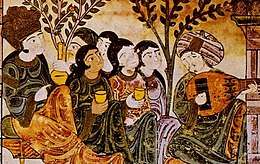Muwashshah
Muwashshah (Arabic: موشح muwaššaḥ literally means "girdled" in Classical Arabic; plural muwaššaḥāt موشحات or tawāšīḥ تواشيح) is the name for both an Arabic poetic form and a secular musical genre. The poetic form consists of a multi-lined strophic verse poem written in classical Arabic, usually consisting of five stanzas, alternating with a refrain with a running rhyme. It was customary to open with one or two lines which matched the second part of the poem in rhyme and meter; in North Africa poets ignore the strict rules of Arabic meter while the poets in the East follow them. The musical genre of the same name uses muwaššaḥ texts as lyrics, still in classical Arabic.[1] This tradition can take two forms: the waṣla of Aleppo and the Andalusi nubah of the western part of the Arab world.
The poetic form
Examples of muwaššaḥ poetry start to appear as early as the 9th or 10th century. The full sense of the word is thought to come from the Syriac word mušaḥta (ܡܘܫܚܬܐ) meaning "rhythm" or "a psalm verse".[2][3] The earliest muwaššaḥs in the Levant are thought to have been heavily influenced by the Syriac sacral music even retaining refrains in Syriac.[3] Some relate it to the word for a type of double-banded ornamental belt, the wišaḥ. The underlying idea is that, as there is a single rhyme running through the refrain of each stanza, the stanzas are like objects hung from a belt.
The musical genre
Musically, the ensemble consists of oud (lute), kamanja (spike fiddle), qanun (box zither), darabukkah (goblet drum), and daf (tambourine): the players of these instruments often double as a choir. The soloist performs only a few chosen lines of the selected text. In Aleppo multiple maqam rows (scales) and up to three awzān (rhythms) are used and modulation to neighboring maqamat was possible during the B section. Until modernization it was typical to present a complete waslah, or up to eight successive muwaššaḥ including an instrumental introduction (sama'i or bashraf).[4] It may end with a longa.
Arguably the most famous Muwashshah still played in the Arab World today is Jadaka Al Ghayth, which has been performed by famous musicians such as Sabah Fakhri and Fairuz.
See also
- Aljamiado
- The kharja is the final stanza of a muwaššaḥ, of which a few are in the Mozarabic language and therefore the first attesting of an Iberian Romance language and first written examples of the Castilian language.
- Zajal
- Fasıl
- Malouf
- Emilio García Gómez
- James T. Monroe
References
- Citations
- Touma 1996, p. 71.
- "Archived copy". Archived from the original on 2011-09-27. Retrieved 2011-06-23.CS1 maint: archived copy as title (link) DIffinition of ܡܘܫܚܬܐ in Classical Syriac
- تعريف الموشحات الأندلسية, Al-Lutus Al-Muhajir Archived 2012-03-25 at the Wayback Machine
- Touma 1996, p. 83.
- Bibliography
- Benbabaali, Saadane, 1987, Poétique du muwashshah dans l'Occident musulman médiéval, thèse de 3e cycle, sous la direction de R. Arié, Paris 3, 1987.
- Benbabaali, Saadane "La plume, la voix et le plectre, avec Beihdja Rahal, Barzakh, Alger, Déc. 2008.
- Benbabaali, Saadane Bahdjat al-Nufûs fî Bahâ'i Djannât al-Andalus (l'Amour, la femme et les jardins dans la poésie andalouse) ANEP, Alger,2010
- Corriente, Federico (1997). Poesía dialectal árabe y romance en Alandalús: cejeles y xarajat de muwassahat. Madrid: Gredos. ISBN 84-249-1887-8.
- Emery, Ed (2006). Muwashshah: proceedings of the Conference on Arabic and Hebrew Strophic Poetry and its Romance Parallels, School of Oriental and African Studies (SOAS), London, 8–10 October 2004. London: RN Books.
- Jones, Alan (1987). Romance Kharjas in Andalusian Arabic Muwassah poetry: a palaeographic analysis. London: Ithaca. ISBN 0-86372-085-4.
- Jones, Alan & Hitchcock, Richard (1991). Studies on the Muwassah and the Kharja: proceedings of the Exeter international colloquium. Reading: Published by Ithaca for the Board of the Faculty of Oriental Studies, Oxford University. ISBN 0-86372-150-8.
- Touma, Habib Hassan (1996). The Music of the Arabs, trans. Laurie Schwartz. Portland, Oregon: Amadeus Press. ISBN 0-931340-88-8.
- Zwartjes, Otto (1997). Love songs from al-Andalus: history, structure, and meaning of the kharja. Leiden: Brill. ISBN 90-04-10694-4.
- Zwartjes, Otto & Heijkoop, Henk (2004). Muwassah, zajal, kharja: bibliography of eleven centuries of strophic poetry and music from al-Andalus and their influence on East and West. Leiden-Boston: Brill. ISBN 90-04-13822-6.
